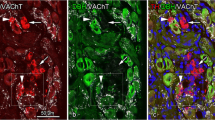Summary
Immunohistochemical localization of the opioid peptides α-neo-endorphin (α-neo-END), dynorphin A (DYN) and leu-enkephalin (leu-ENK) in the guinea pig superior cervical ganglion (SCG) was studied following central denervation, peripheral axotomy, and after application of the depleting drug reserpine and of the neurotoxin 6-hydroxydopamine. The paraganglionic cells of the SCG are shown to form an intrinsic opioid — (α-neo-END, DYN, leu-ENK) — immunoreactive system being not visibly responsive to the experimental procedures. Leu-ENK-immunoreactive fibres ascend in the preganglionic trunk and supply fibre baskets to defined clusters of postganglionic neurones. Principal ganglion cells of the SCG containing α-neo-END-and DYN-immunoreactivity project to extraganglionic targets via the postganglionic nerves. These findings are indicative of a sympathetic α-neo-END-ergic and DYN-ergic innervation of effector organs. They also point to a modulatory function of opioids on neuronal activity in a paravertebral ganglion.
Similar content being viewed by others
References
Bonnard C, Papermaster DS, Kraehenbuhl JP (1984) The streptavidin-biotin bridge technique: application in light and electron microscope immunocytochemistry. In: Polak JM, Varndell IM (eds) Immunolabelling for electron microscopy. Elsevier Amsterdam, pp 95–112
Cattabeni FS, Koslow H, Costa E (1972) Gas-chromatography, mass-fragmentography: a new approach to the estimation of amines and amine turnover. Adv Biochem Psychopharmacol 6:37–59
Costa M, Furness JB, Cuello AC (1985) Separate populations of opioid containing neurons in the guinea-pig intestine. Neuropeptides 5:445–448
Dalsgaard CJ, Hökfelt T, Elfvin LG, Terenius L (1982) Enkephalin-containing sympathetic preganglionic neurons projecting to the inferior mesenteric ganglion: evidence from combined retrograde tracing and immunohistochemistry. Neuroscience 7:2039–2050
Dalsgaard CJ, Hökfelt T, Schultzberg M, Lundberg JM, Terenius L, Dockray DJ, Goldstein M (1983) Origin of peptide-containing fibres in the inferior mesenteric ganglion of the guinea pig: immunohistochemical studies with antisera to substance P, enkephalin, vasoactive intestinal polypeptide, cholecystokinin and bombesin. Neuroscience 9:191–211
Gu J, Huang WM, Blank M, Morrison JFB, Bloom SR, Polak JM (1983) Measurement of VIP and origin of its innervation in the rat urinary bladder. Regul Pept 6:305
Heym C (1985) Neuropeptides in paraganglia of various mammals. In: Duncker HR, Fleischer G (eds) Functional morphology in vertebrates, Fortschritte der Zoologie, vol 30. Fischer, Stuttgart New York, pp 563–569
Horikawa S, Takai T, Toyosato M, Takahashi H, Noda M, Kakidani H, Kubo T, Hirose T, Inayama S, Hayashida H, Miyata T, Numa S (1983) Isolation and structural organization of the human preproenkephalin B gene. Nature 306:611–614
Jew JY (1985) Histofluorescence and ultrastructural observations of small intensely fluorescent (SIF) cells in the superior sympathetic ganglion of the guinea pig. Cell Tissue Res 241:529–538
Kakidani H, Furutani Y, Takahashi H, Noda M, Morimoto Y, Hirose T, Asai M, Inayama S, Nakanishi S, Numa S (1982) Cloning and sequence analysis of cDNA for procine β-neoendorphin/dynorphin precursor. Nature 298:245–249
Kessler JA, Black IB (1982) Regulation of substance P in adult rat sympathetic ganglia. Brain Res 234:182–187
Kummer W, Heym C (1986) Correlation of neuronal size and peptide-immunoreactivity in the guinea pig trigeminal ganglion. Cell Tissue Res 245:657–665
Lang RE, Hermann K, Dietz R, Gaida W, Ganten D, Kraft K, Unger T (1983) Evidence for the presence of enkephalins in the heart. Life Sci 32:399–406
Malmfors T, Thoenen H (eds) (1971) 6-hydroxydopamine and catecholamine neurons. North-Holland, Stockholm
Mattiasson A, Ekblad E, Sundler F, Uvelius B (1985) Origin and distribution of neuropeptide Y-, vasoactive intestinal polypeptide-and substance P-containing nerve fibres in the urinary bladder of the rat. Cell Tissue Res 239:141–146
Schultzberg M, Hökfelt T, Terenius L-G, Lundberg JM, Brandt J, Elde RP, Goldstein M (1979) Enkephalin immunoreactive nerve fibres and cell bodies in sympathetic ganglia of the guinea pig and rat. Neuroscience 4:249–270
Sternberger LA (1979) Immunocytochemistry. Wiley, New York
Vincent SR, Dalsgaard CJ, Schultzberg M, Hökfelt T, Christensson I, Terenius L (1984) Dynorphin-immunoreactive neurons in the autonomic nervous system. Neuroscience 11:973–987
Weihe E, Hartschuh W, Weber E (1985) Prodynorphin opioid peptides in small somatosensory primary afferents of guinea pig. Neurosci Lett 58:347–352
Xiang JZ, Archelos J, Lang R (1984) Enkephalins in the heart. Clin Exp Theory Practice 6 (10+11):1883–1888
Author information
Authors and Affiliations
Rights and permissions
About this article
Cite this article
Kummer, W., Heym, C., Colombo, M. et al. Immunohistochemical evidence for extrinsic and intrinsic opioid systems in the guinea pig superior cervical ganglion. Anat Embryol 174, 401–405 (1986). https://doi.org/10.1007/BF00698790
Accepted:
Issue Date:
DOI: https://doi.org/10.1007/BF00698790




